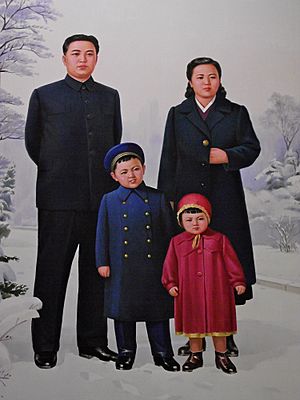Kim Kyong-hui facts for kids
Quick facts for kids
General
Kim Kyong-hui
|
|
|---|---|
| 김경희 | |

Kim Kyong-hui as a small child on a propaganda portrait, 1966
|
|
| Born | 30 May 1946 Pyongyang, North Korea
|
| Education |
|
| Office | Secretary for Organization of the Workers' Party of Korea; Korean People's Army general |
| Political party | Workers' Party of Korea |
| Spouse(s) | |
| Children |
|
| Parent(s) | |
| Awards | |
| Korean name | |
| Chosŏn'gŭl |
김경희
|
| Hancha |
金慶喜/金敬姬
|
| Revised Romanization | Gim Gyeonghui |
| McCune–Reischauer | Kim Kyŏnghŭi |
Kim Kyong-hui (born 30 May 1946) is an important political figure in North Korea and the aunt of its current leader, Kim Jong Un. She is the daughter of North Korea's first leader, Kim Il Sung, and the younger sister of the second leader, Kim Jong Il.
As a key member of her brother's group of trusted advisors, she held many powerful jobs. For many years, she was the director of the Light Industry Department for the Workers' Party of Korea (WPK). She was married to Jang Song-thaek, who was a high-ranking official before he was removed from power and died in 2013.
Contents
Early Life and Schooling

Kim Kyong-hui was born in Pyongyang, the capital of North Korea. Her parents were Kim Il Sung and his first wife, Kim Jong Suk. Sadly, her mother passed away when she was only four years old.
During the Korean War, she and her brother, Kim Jong Il, briefly lived in Jilin Province, China. After the war, they returned to Pyongyang.
In 1963, she began studying political economy at Kim Il Sung University. She later attended the Kim Il Sung Higher Party School and also studied at Moscow State University in Russia in 1968.
A Career in Politics
Kim Kyong-hui started her political career in 1971. Her first role was with the Korean Democratic Women's Union. In 1975, she moved to an important job in the International Liaison Department of the Workers' Party of Korea. This department handled North Korea's relationships with other countries.
She helped choose skilled people to work as diplomats as North Korea began to form relationships with countries like Thailand and Singapore.
Growing Influence
In 1988, Kim was given a top position as a member of the WPK Central Committee. She also became the director of the Light Industry Department. This department was in charge of making everyday goods for the people. In 1990, she was elected as a representative to the Supreme People's Assembly, North Korea's parliament.
Her role became even more important after her father, Kim Il Sung, died in 1994. She led departments that focused on the country's economy during a very difficult time known as the "Arduous March."
| The Kim family tree (DPRK) | ||||||||||||||||||||||||||||||||||||||||||||||||||||||||||||||||||||||||||||||||||||||||||||||||||||||||||||||||||||||||||||||||||||||||||||||||||||||||||||||||||||||||||||||||||||||||||||||||||||||||||||||||||||||||||||||||||||||||||||||||||||||||||||||||||||||||||||||||||||||||||||||||||||||||||||||||||||||||||||||||||||||||||||||||||||||||||||||||||||||||||||||||||||||||||||||||||||||||||||||||||||||||||||||||||||||
|---|---|---|---|---|---|---|---|---|---|---|---|---|---|---|---|---|---|---|---|---|---|---|---|---|---|---|---|---|---|---|---|---|---|---|---|---|---|---|---|---|---|---|---|---|---|---|---|---|---|---|---|---|---|---|---|---|---|---|---|---|---|---|---|---|---|---|---|---|---|---|---|---|---|---|---|---|---|---|---|---|---|---|---|---|---|---|---|---|---|---|---|---|---|---|---|---|---|---|---|---|---|---|---|---|---|---|---|---|---|---|---|---|---|---|---|---|---|---|---|---|---|---|---|---|---|---|---|---|---|---|---|---|---|---|---|---|---|---|---|---|---|---|---|---|---|---|---|---|---|---|---|---|---|---|---|---|---|---|---|---|---|---|---|---|---|---|---|---|---|---|---|---|---|---|---|---|---|---|---|---|---|---|---|---|---|---|---|---|---|---|---|---|---|---|---|---|---|---|---|---|---|---|---|---|---|---|---|---|---|---|---|---|---|---|---|---|---|---|---|---|---|---|---|---|---|---|---|---|---|---|---|---|---|---|---|---|---|---|---|---|---|---|---|---|---|---|---|---|---|---|---|---|---|---|---|---|---|---|---|---|---|---|---|---|---|---|---|---|---|---|---|---|---|---|---|---|---|---|---|---|---|---|---|---|---|---|---|---|---|---|---|---|---|---|---|---|---|---|---|---|---|---|---|---|---|---|---|---|---|---|---|---|---|---|---|---|---|---|---|---|---|---|---|---|---|---|---|---|---|---|---|---|---|---|---|---|---|---|---|---|---|---|---|---|---|---|---|---|---|---|---|---|---|---|---|---|---|---|---|---|---|---|---|---|---|---|---|---|---|---|---|---|---|---|---|---|---|---|---|---|---|---|---|---|---|---|---|---|---|---|---|---|---|---|---|---|---|---|---|---|---|---|---|---|---|---|---|---|---|---|---|---|---|---|---|---|---|---|---|---|---|---|
|
||||||||||||||||||||||||||||||||||||||||||||||||||||||||||||||||||||||||||||||||||||||||||||||||||||||||||||||||||||||||||||||||||||||||||||||||||||||||||||||||||||||||||||||||||||||||||||||||||||||||||||||||||||||||||||||||||||||||||||||||||||||||||||||||||||||||||||||||||||||||||||||||||||||||||||||||||||||||||||||||||||||||||||||||||||||||||||||||||||||||||||||||||||||||||||||||||||||||||||||||||||||||||||||||||||||
First Female General
After being out of the public eye for a few years, Kim Kyong-hui returned in 2009. She began appearing with her brother, Kim Jong Il, at official events and tours.
On September 27, 2010, she was made a general in the Korean People's Army. She was the first woman in North Korea to receive this high military rank. Her nephew, Kim Jong Un, was promoted to the same rank at the same time. The next day, she was also named a member of the Political Bureau, a very powerful group within the Workers' Party.
After her brother's death, she continued to be a leading figure under her nephew, Kim Jong Un.
Personal Life
Kim Kyong-hui met her husband, Jang Song-thaek, while they were both students at Kim Il Sung University. They married in 1972.
They had one daughter, Jang Kum-song (1977–2006). She was a student studying in Paris, France, where she passed away in 2006.
In 2013, her husband Jang Song-thaek was publicly removed from all his powerful government positions. He passed away shortly after. Even after this, Kim Kyong-hui's name was included on a list for an official state committee, showing that she remained an important figure.
Later Years and Public Appearances
For many years, Kim Kyong-hui was not seen in public. This led to many rumors and stories about her health and whether she was still alive. Some reports claimed she was very ill, while others said she was receiving medical care.
However, in January 2020, she made a surprise appearance. She attended a Lunar New Year concert with her nephew, Kim Jong Un. It was the first time she had been seen in public in more than six years.
See also
 In Spanish: Kim Kyong-hui para niños
In Spanish: Kim Kyong-hui para niños
- Kim Song-hye
- Kim Sol-song
- Kim Yo Jong
- Politics of North Korea
- Ro Song-sil
- Women in North Korea

